
Dearly beloved brothers and sisters,
World's Last Chance is overjoyed to share what we sincerely believe to be advancing light on our Creator's calendar. In His great mercy and longsuffering, Yahuwah has bore long with us as we espoused what we now recognize to be an error. Praise His Name! Since we first accepted the glorious light of Yahuwah's luni-solar calendar and its divine role in determining all of the Feast Days, including the Seventh Day Sabbath, we have in our ignorance proclaimed that New Moon Day was determined by the first visible crescent. We now, after much prayer and study, repent of this error and would like to humbly share our conviction that New Moon Day is to be observed, beginning at dawn, on the day following the moon's conjunction with the sun (as opposed to the day following the first visible crescent).
We also confess that we were slow to see the error of determining Abib 1 (the Biblical New Year) based on the ripening barley. Some of our former WLC members saw this error early on and had pointed it out to us in no uncertain words. While we could not see this error then, we wish we had been more responsive at the time, and Praise His Name that we see it now. For those members who were offended by our erroneous position on barley and other related errors, we offer our most humble and sincere apologies and earnestly seek His forgiveness and yours.
World's Last Chance is committed to following the Lamb wherever He goes, be the cost what it may. We are committed to pursuing and embracing the light of His unchanging Truth at every turn, and it is our prayer that you, too, will commit yourself always to the weight of evidence. May our loving heavenly Father lead us into all truth to His glory alone! Below, you will find what we believe to be sufficient evidence for discarding the first visible crescent methodology in favor of the dawn after conjunction. May Yahuwah bless you and guide you as you commit yourself wholly to His care.
In Yahushua's Service & Care,
The WLC Team
Sadly, we do not find in Scripture a clear explanation of exactly how to reckon New Moon Day. In recognition of this fact, we must carefully and prayerfully sort through every piece of evidence available before drawing any conclusions. Even in the absence of what is perceived to be overwhelming proof, we must be faithful to what we have before us; we must be willing always to follow the weight of evidence wherever it may lead.
The moon begins to illuminate immediately after conjunction. We cannot see it, though, until the sun sets because the moon is obscured by the greater light of the sun. The fact that we cannot see the moon immediately after conjunction, however, does not negate the fact that it has already began a new revolution with new illumination. Often, the first visible crescent will be seen on the evening of New Moon Day, displaying her new light to the viewer.
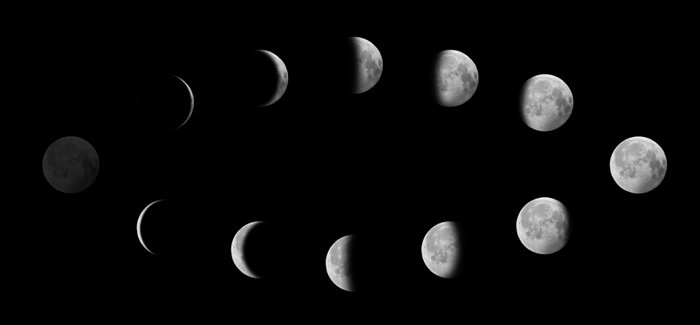 |
|
The moon begins re-illuminating immediately after passing through conjunction with the sun. |
The reason for making the day after conjunction New Moon Day, as opposed to the actual day that conjunction takes place, is because a day cannot simultaneously be part of the old month and part of the new month. Therefore, the first dawn after conjunction takes place is the beginning of the new month. There are two main arguments, which have compelled us to make the shift from the First Visible Crescent to First Dawn After Conjunction:
These are the feasts of Yahuwah, even holy convocations, which you shall proclaim in their seasons [appointed times]. (See Leviticus 23:4.)
The divine command to keep Yahuwah's holy days at their appointed times cannot truly be met and obeyed except through the First Dawn After Conjunction method. We firmly believe that there is one Sabbath day to be kept by the whole world, and that the whole world is to keep Yahuwah's feasts on a specified day, and not over several days. The First Dawn After Conjunction method uniquely and miraculously unites the entire world on one solar revolution. Here is how it works:
When reckoning the dawn after conjunction as the beginning of New Moon Day, the entire world will be united in observing the same day. While it might appear that two different days are being observed when communicating the dates via the Gregorian calendar, in reality everyone on earth will be observing the New Moons, Sabbaths, and Feast Days during the same solar revolution, each beginning their day within the same 24-hour period. In other words, all countries of the world will experience the arrival of His Sabbath and Feast Days within one 24-hour solar revolution. Thus, the whole world is truly unified in beginning His Holy Days within one 24-hour period. Using this method, a divinely-appointed worldwide Date Line is established each month by the Creator.
The first visible crescent method for reckoning New Moon Day, however, cannot consistently unite the world in beginning the feasts in the same 24-hour revolution. Scripture commands us to observe the Sabbath, not a Sabbath. Does it then make sense that there would be multiple Sabbaths in the same week? Does it make sense for different locals to celebrate the Sabbath 48 hours apart? Only by reckoning the day after conjunction as New Moon Day can everyone on Earth consistently observe one Sabbath Day.
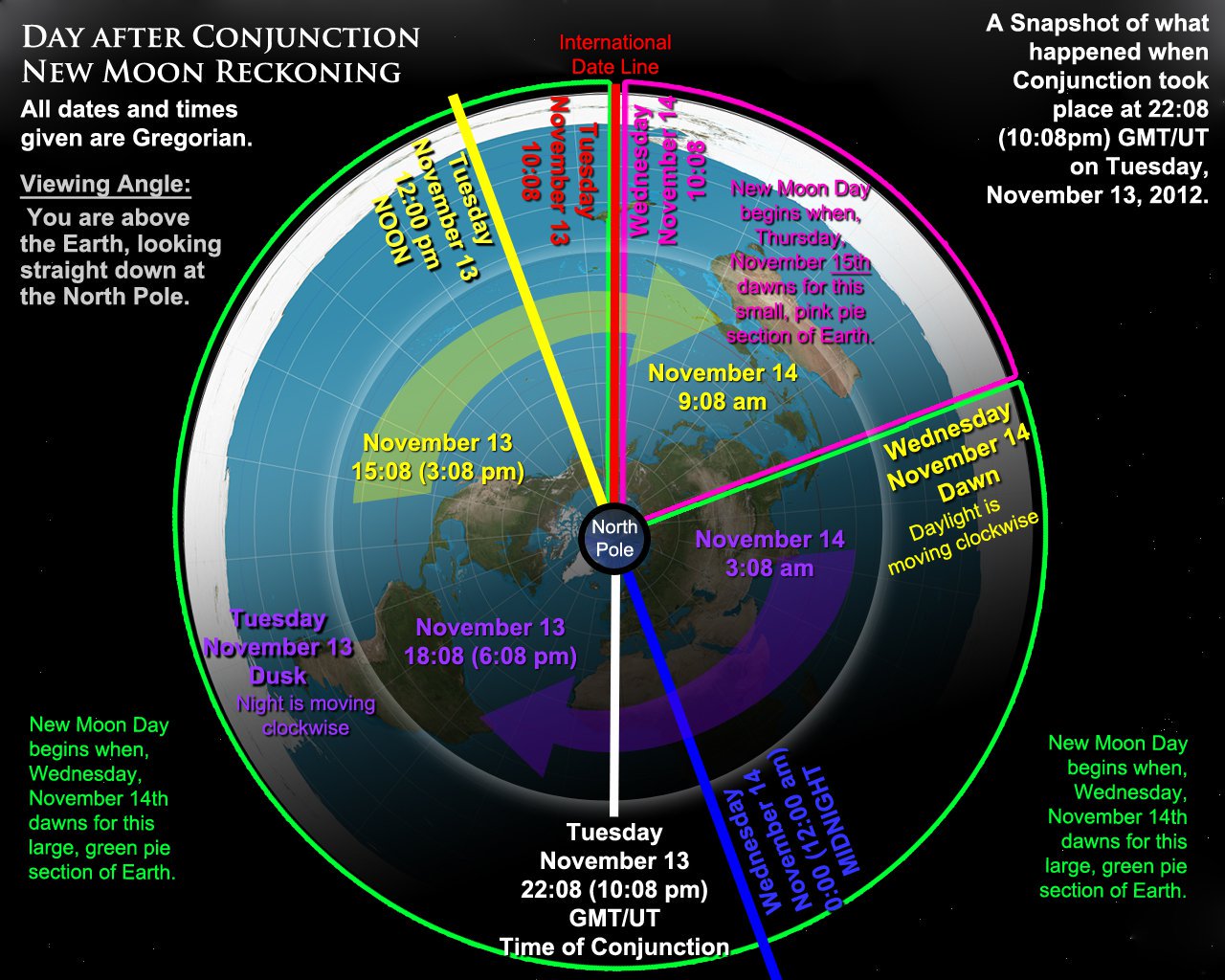
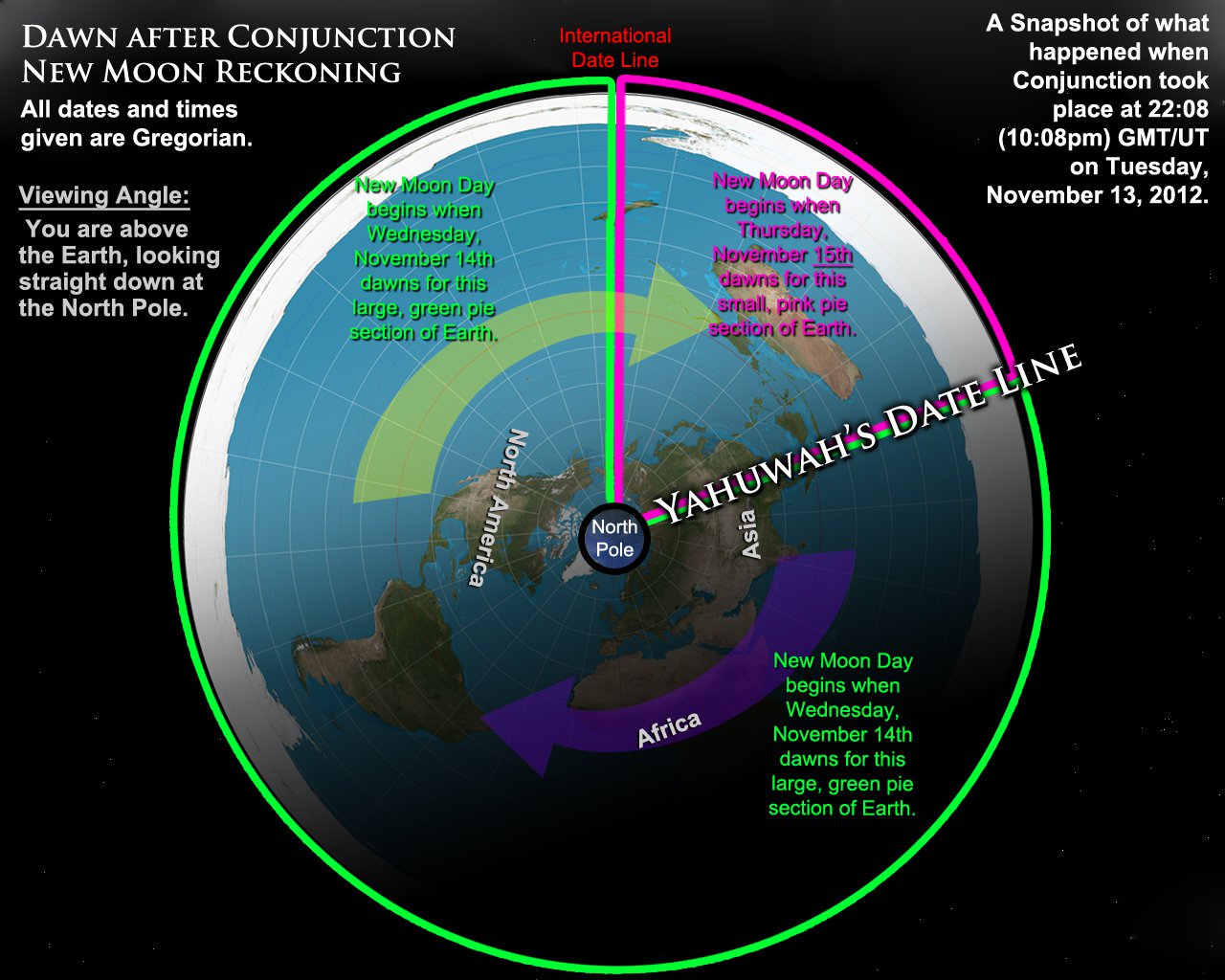
This method allows the entire world to begin their New Moons, Sabbaths, and Feast Days on the same 24-hour Solar Revolution.
The International Date Line...
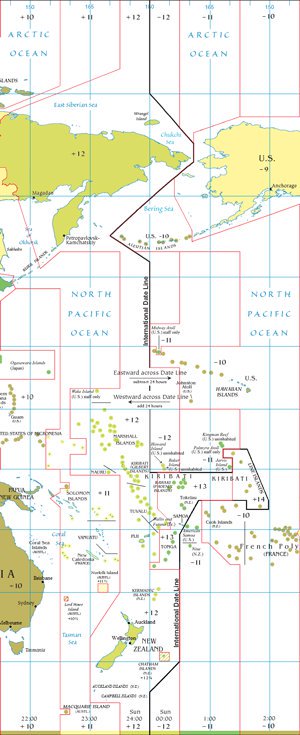 The International Date Line (IDL) is simply an imaginary line that was devised by the International Meridian Conference in Washington, DC in October 1884 CE. The Conference was comprised of astronomers and representatives from 25 countries.1 The participants created the first IDL with little or no regard for the island nations that it divided. Today, the IDL roughly zig-zags its way through the Pacific Ocean around the 180° longitude, basically dividing the world into two Gregorian calendar dates. There is no natural phenomenon that happens there; in other words, it is completely arbitrary. The location of the IDL was chosen because it is situated exactly opposite of the Prime Meridian (yet another completely arbitrary, man-made construct) and the point of Coordinated Universal Time (UTC) or Greenwich Mean Time (GMT). It is also predominately over the ocean. Time and dates plug along in what seems to be an orderly and predictable fashion, completely detached from signifiers in nature, much like a machine that has been wound up and let go. As you can see by the image to the left, the IDL and subsequent time zones are very complex.2 They were designed by man relatively recently and are entirely random in their locations. Is this the way that our Loving Creator designed His time to be structured? What does Scripture say about calendation?
The International Date Line (IDL) is simply an imaginary line that was devised by the International Meridian Conference in Washington, DC in October 1884 CE. The Conference was comprised of astronomers and representatives from 25 countries.1 The participants created the first IDL with little or no regard for the island nations that it divided. Today, the IDL roughly zig-zags its way through the Pacific Ocean around the 180° longitude, basically dividing the world into two Gregorian calendar dates. There is no natural phenomenon that happens there; in other words, it is completely arbitrary. The location of the IDL was chosen because it is situated exactly opposite of the Prime Meridian (yet another completely arbitrary, man-made construct) and the point of Coordinated Universal Time (UTC) or Greenwich Mean Time (GMT). It is also predominately over the ocean. Time and dates plug along in what seems to be an orderly and predictable fashion, completely detached from signifiers in nature, much like a machine that has been wound up and let go. As you can see by the image to the left, the IDL and subsequent time zones are very complex.2 They were designed by man relatively recently and are entirely random in their locations. Is this the way that our Loving Creator designed His time to be structured? What does Scripture say about calendation?
And Elohim said, ‘Let there be lights in the firmament of the heaven to divide the day from the night; and let them be for signs, and for seasons, and for days, and years… (Gen 1:14)
Using the Creator’s Calendar and His divinely ordained luminaries in the sky, nothing is arbitrary or insignificant. The phases of the moon, the rising and setting of the sun, and even the position of the stars are all relevant.3 When using the Creator’s Calendar, the first dawn after the Lunar/Solar Conjunction marks the beginning of the date line. Dawn then moves forward from that point bringing with it New Moon Day to the world. This method will ultimately unite the whole world on one 24-hour solar revolution which is not possible with any other method for reckoning the New Moon. This method gives the sun and the moon back their governance over the seasons, or môʿēd < Strong's H4150>, the month, the Sabbaths, and the Feasts. If the “Dawn After Conjunction” method had been kept throughout the centuries since creation, there would have been no reason to conjure up the man-made IDL. Although Yahuwah's date line, which could also be called His "dawn line", changes geographically from one month to the next, the Dawn after Conjunction is the one lunar method that miraculously unites the whole world on one 24-hour solar revolution. (It will be discussed later why the Full Moon cannot serve as the New Moon. Refer to the section, entitled "Problems with Using the Day following the Full Moon".)
Not only does this method unite the world in observing the Feasts on one 24-hour Solar Revolution, but none will begin New Moon Day more than 24 hours after the actual Conjunction takes place. Remarkably, there are only 24 hours from the time of Conjunction until New Moon Day dawns in the last geographic region to receive the day. This is an amazing testimony to the uniqueness and consistency of Yahuwah's worldwide date line.
1 http://www.staff.science.uu.nl/~gent0113/idl/idl_imc1884.htm
2 http://en.wikipedia.org/wiki/File:International_Date_Line.png
3 The position of the stars in relation to the Sun and the Moon in regards to Biblical calendation is something that the WLC Team continues to study.
A Biblical day begins at dawn, at the earliest introduction of light, and ends at dusk, with the complete absence of light. In a consistent pattern, the month begins with the first dawn immediately after the moon becomes illuminated and ends when the moon is completely void of light at the conjunction. (Not being able to see the moon's initial illumination does not change the reality that it is taking place. The light of the first visible crescent is only evidence of what began taking place immediately following the moon's conjunction with the sun.)
The Hebrew word for "New Moon" is chodesh (H2320), which is also translated as "month." Chodesh appears in Scripture more than 270 times, yet it is not used even once to denote seeing something (i.e. the visible moon, the crescent, etc.). Rather, the Hebrew word signifying the physical, observable moon is yerach (H3391, H3393, & H3394). Yerach is translated 28 times as "moon" and 13 times as "month," but is never used to signify the New Moon.
Note: There is a Hebrew word for "crescent" - śaharōnîm (H7720). However, it is used exclusively in connection to heathen idolatry (Judges 8:21 & 26; Isaiah 3:18), and is never associated with the "New Moon" or even the "month." More on this later. Refer to the section below, entitled "Problems with Using the First Visible Crescent ."
"Blow up the trumpet in the new moon, in the time appointed [H3677], on our solemn feast day [H2282]." (Psalm 81:3, KJV)
H3677 (keh'-seh) - Apparently from H3680; properly fulness or the full moon, that is, its festival: - (time) appointed. (Strong's Greek & Hebrew Dictionary)1
H2282 (khag) -This word refers especially to a "feast observed by a pilgrimage." (The New Strong's Expanded Dictionary of Bible Words)
Psalm 81:3, then, tells us two things:
In context, Psalm 81 is talking about Israel's exodus from the land of Egypt. It seems only reasonable to conclude then that the pilgrimage feast being referred to here is the Feast of Unleavened Bread, which begins on the 15th day of the lunar month (on the same day that the children of Israel were led out of Egypt). Some have suggested that Psalm 81:3 is referring to the Feast of Trumpets (New Moon Day) and the Feast of Tabernacles (beginning on the 15th) in the seventh month. This seems unlikely given the context of the entire chapter. However, even this interpretation places the full moon at the end of the second week on the 15th of the month. There is no way to honestly reconcile this verse with the first visible crescent methodology for reckoning New Moon Day, as the first visible crescent method generally places the full moon on the 13th/14th of the month. Reckoning the day after conjunction as New Moon Day, however, places the full moon on the 14th/15th of the month, which is in harmony with Psalm 81:3. This is also in harmony with The Writings of Philo. See "The Historical Argument" below. (It should be noted here that there are occasional anomalies in the moon’s behavior, meaning there are times when the moon will not become 100% full until the 16th day of the lunar month. Click here for more.)
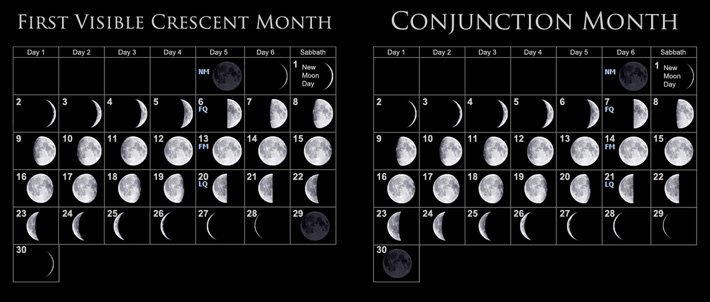
Please Note: This is an ideal representation of the Lunar Month when reckoning by the first visible crescent and the Dawn after Conjunction. Because the Moon can achieve the perfect Quarter, Full, and Conjunction phases at any time during a 24-hour period, and since most (if not all) programs/calendars use a midnight to midnight reckoning of a date, you will sometimes see the perfect phases shown a day earlier or a day later, making them not always line up exactly. When reckoning by the first visible crescent, there is actually more variance (from month to month) than what is shown in the depiction above because there are several variables involved in determining the earliest visibility of the moon. The Dawn after Conjunction method establishes a much more consistent pattern of phases.
1 Some have suggested that keh'seh, based on its root word (H3680; kâsâh), should be translated as "concealed moon" as opposed to "full moon," meaning that the trumpet should be sounded when the moon is dark (i.e. conjunction) to signal New Moon Day. Even this interpretation is in harmony with the dawn after conjunction method of reckoning.
Darkness (an actual segment of time) preceded day one of Creation week. That is to say that the very first day of the very first month in Earth's history was dark; no light preceded this day. Why should we expect subsequent months to be any different?
"In the beginning Elohim created the heaven and the earth. And the earth was without form, and void; and darkness was upon the face of the deep. And the Spirit of Elohim moved upon the face of the waters. --- And Elohim said, Let there be light: and there was light." (Genesis 1:1-3, RNKJV)
Ezekiel 46:1 establishes that there are three different types of days: (1) New Moon Days; (2) Work Days; (3) Sabbath Days
Thus says the Master Yahuwah: "The gateway of the inner court that faces toward the east shall be shut the six working days; but on the Sabbath it shall be opened, and on the day of the New Moon it shall be opened." (See Ezekiel 46:1.)
It stands to reason that the different classes of days would be delineated in nature (Creation). When reckoning the dawn after conjunction as the commencement of New Moon Day, we find that each type of day is generally marked by specific moon phases: (1) New Moon Day is preceded by darkness (conjunction); (2) Work days are preceded by the illuminated phases (excluding the quarter phases).1 (3) Sabbath Days are preceded by the quarter phases. Thus, this method makes consistently identifying the Sabbaths by the moon's appearance much easier and more practical. It seems that Creation itself testifies to this method of reckoning.
1 The crescent moon will often be visible to the naked eye on New Moon Day (on the evening before the first day of the workweek), but this will not always be the case.
A record of the Christian transition to pagan calendation has been preserved in various sepulchral inscriptions. One of the oldest dated Christian sepulchral inscriptions to be discovered in Rome refers to dies Veneris (day of Venus). What sets this particular inscription apart is that it lists both the Julian date and the luni-solar date. Dated A.D. 269, it states:
In the consulship of Claudius and Paternus, on the Nones of November, on the day of Venus, and on the 24th day of the lunar month, Leuces placed [this memorial] to her very dear daughter Severa, and to Thy Holy Spirit. She died [at the age] of 55 years, and 11 months [and] 10 days. (E. Dichl, Inscriptiones Latinæ Christianæ Veteres, Vol. 2, p. 193, #3391. See also, J. B. de Rossi, Inscriptiones Christianæ Urbis Romæ, Vol. 1, part 1, p. 18, #11.)
The “Nones” of November is November 5 which fell that year on the day of Venus, Friday. In that lunation, this corresponded with the 24th day of the lunar month, or “Second Day” on the Biblical week. Examining the dates here with astronomy software, we find that New Moon Day (the first day of the lunar month) was reckoned as the day after conjunction.
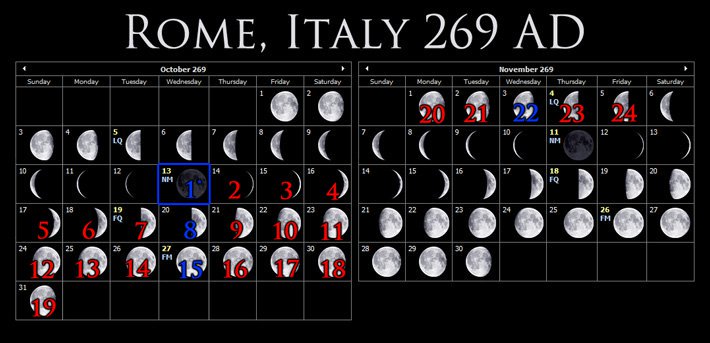
*Please Note: Conjunction actually happened in Rome at 2:05 am (October 13), well before dawn.
This is why the day of Conjunction appears to be day 1 and not day 29 or 30 of the previous month (lunation).
Philo (a Hellenistic Jewish Philosopher from Alexandria) lived before, during, and after our Saviour's earthly ministry. It stands to reason, then, that he would have espoused a correct understanding of Biblical calendation.
 |
|
Philo of Alexandria (20 B.C.–50 A.D.), |
In the below quotation, Philo says that the New Moon festival takes place when the moon begins to illuminate. As previously stated, the moon becomes illuminated immediately after conjunction. We cannot see it, though, until the sun sets because the moon is obscured by the greater light of the sun. The fact that we cannot see the moon immediately after conjunction, however, does not negate the fact that it has already began a new revolution and is again re-illuminating. Often, the first visible crescent will be seen on the evening of New Moon Day, displaying to the viewer her new light.
“Following the order which we have adopted, we proceed to speak of the third festival, that of the new moon. First of all, because it is the beginning of the month, and the beginning, whether of number or of time, is honorable. Secondly, because at this time there is nothing in the whole of heaven destitute of light. Thirdly, because at that period the more powerful and important body gives a portion of necessary assistance to the less important and weaker body; for, at the time of the new moon, the sun begins to illuminate the moon with a light which is visible to the outward senses, and then she displays her own beauty to the beholders…" (Philo, Special Laws II, Section XXVI (140-142), emphasis supplied)
In the following quotations, Philo plainly states that New Moon Day follows conjunction and that months are reckoned from conjunction to conjunction.
"The third [festival] is that which comes after the conjunction, which happens on the day of the new moon in each month." (Philo, Special Laws II, Section XI (41))
"This is the New Moon, or beginning of the lunar month, namely the period between one conjunction and the next, the length of which has been accurately calculated in the astronomical schools." (Philo, Special Laws II, Section XXVI (140)) Note: The Hendrickson Publishers edition (1993) of C. D. Jonge’s 1854 translation does not have the same information that the Colson translation gives. The indications are that the conjunctions were determinative in deciding the first of the month.
Philo's statements below indicate that the moon completes its perfect configurations (i.e. waxing half-moon, full moon, waning half-moon, conjunction) at the end of each week. When reckoning the dawn after conjunction as the commencement of New Moon Day, this is most often the case.
“Again, the periodical changes of the moon, take place according to the number seven, that star having the greatest sympathy with the things on earth. And the changes which the moon works in the air, it perfects chiefly in accordance with its own configurations on each seventh day. At all events, all mortal things, as I have said before, drawing their more divine nature from the heaven, are moved in a manner which tends to their preservation in accordance with this number seven. … Accordingly, on the seventh day, Elohim caused to rest from all his works which he had made.” (Philo, Allegorical Interpretation, 1, Section IV (8-9), Section VI (16))
“…there is one principle of reason by which the moon waxes and wanes in equal intervals, both as it increases and diminishes in illumination; the seven lambs because it receives the perfect shapes in periods of seven days—the half-moon in the first seven day period after its conjunction with the sun, full moon in the second; and when it makes its return again, the first is to half-moon, then it ceases at its conjunction with the sun.” (Philo, Special Laws I, (178))
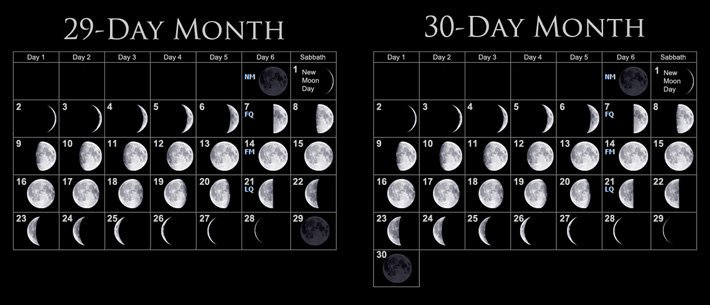
Please Note: This is an ideal representation of the Lunar Month when reckoning New Moon Day as the Day After Conjunction. Because the Moon can achieve the perfect Quarter, Full, and Conjunction phases at any time during a 24-hour period, and since most (if not all) programs/calendars use a midnight to midnight reckoning of a date, you will sometimes see the perfect phases shown a day earlier or a day later, making them not always line up exactly. You will need to check the time of Conjunction for your specific area.
Below, our interpretation of Philo's previous statements is confirmed. Here, Philo states that the moon should be full at the end of the second week (i.e. the 15th day of the lunar month). Note: When reckoning the day after conjunction as New Moon Day, the moon will full on the 14th or 15th of the month.
“For it is said in the Scripture: On the tenth day of this month let each of them take a sheep according to his house; in order that from the tenth, there may be consecrated to the tenth, that is to [Elohim], the sacrifices which have been preserved in the soul, which is illuminated in two portions out of the three, until it is entirely changed in every part, and becomes a heavenly brilliancy like a full moon, at the height of its increase at the end of the second week . . .” (On Mating with the Preliminary Studies, Section XIX, (106))
“And this feast is begun on the fifteenth day of the month, in the middle of the month, on the day on which the moon is full of light, in consequence on the providence of Elohim taking care that there shall be no darkness on that day.” (Philo, Special Laws II, The Fifth Festival, Section XXVIII (155))
This is in perfect harmony with Psalm 81:3. (See "The Biblical Argument" above.)
Some lunar Sabbatarians advocate observing the very day that conjunction takes place as New Moon Day, as opposed to the first day after conjunction. The problem with this method is that the new month is begun before the old month is finished. The lunation (month) is not truly over until the moon enters conjunction with the sun, after which it will again become illuminated as it begins a new revolution. The reason for making the day after conjunction New Moon Day, as opposed to the actual day that conjunction takes place, is because a day cannot simultaneously be part of the old month and part of the new month. Therefore, the first dawn after conjunction takes place is the beginning of the new month.
Some lunar Sabbatarians teach that New Moon Day is the day after Conjunction, provided the first visible crescent is sighted that evening. This, they say, is because the first visible crescent is the signal to begin the workweek. This method requires that the day after the last Sabbath on the 29th always be observed as a New Moon Day. If the first visible crescent moon is seen on that evening, then that day was New Moon Day. If the first visible crescent is not seen, then that day was the 30th and the following day will be New Moon Day. There are two insurmountable issues with employing this method:
Some have suggested that New Moon Day follows the day on which the waning crescent can no longer be seen before sunrise. This is because it is supposed that the disappearance of the moon indicates that conjunction will take place later that day, making the following day New Moon Day.
The proposed method: "As the moon grows old (wanes), every morning a smaller and smaller crescent is seen closer and closer to the eastern horizon. Conjunction day is the day the sun rises without the moon being seen first. The following day would then be New Moon Day, as it would be the first new day after Conjunction. If the waning crescent can be seen on the morning of the last Sabbath (the 29th day of the lunar month), then it will be a 30-day month. If the waning crescent cannot be seen on the morning of the last Sabbath, it will be a 29-day month."
While this method aims for identifying the correct day as New Moon Day (i.e. the Dawn after Conjunction), it is not reliable and cannot be used to consistently and accurately identify the day of Conjunction. Consequently, this method cannot be used to determine New Moon Day.
For example: In New Delhi, India, on the morning of November 13, 2012, the waning crescent could still be seen in the eastern sky. (November 13 was the last Sabbath of the lunation, the 29th day of the lunar month.)
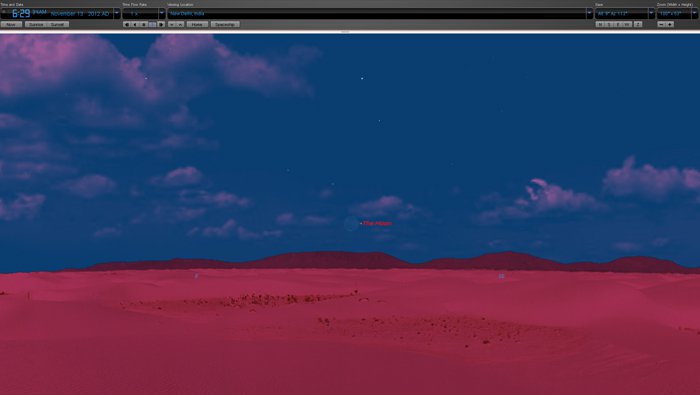
New Delhi, India - November 13, 2012, just before sunrise
Using the method in discussion, it would then be assumed that November 14 would be the 30th day of the month, and that November 15 would be New Moon Day. However, because Conjunction happened before dawn on November 14, November 14 was actually New Moon Day.1 Using the proposed method here, New Moon Day would be declared one day late. While the aim is good, the method is faulty.
Some lunar Sabbatarians teach that New Moon Day follows the day on which the waning crescent can no longer be seen before sunrise - regardless of when the actual conjunction occurs. This method, however, divides the world in the same way that the first visible crescent does. Because the sighting of the last visible crescent is specific to one's geographic location, the world will not be united in beginning the Sabbaths and Feast Days on the same 24-hour solar revolution.
Some lunar Sabbatarians teach that New Moon Day begins with the first sunset after Conjunction. This, of course, cannot be so. Scripture clearly teaches that a day begins at DAWN, not sunset. The traditional practice of observing all days from sunset to sunset (evening to evening) is a Babylonian custom that was adopted by the Jews after the first century.
A Biblical day begins at dawn and ends at dusk1:
___________________________________________________________
1 It is very easy to allow our presuppositions to shape the way we interpret Scripture. Many sincere individuals and ministries who advocate evening to evening days have done just this. We humbly urge all who are clinging to the erroneous doctrine that a day begins at sunset to lay all preconceptions at the door of investigation, and to honestly and prayerfully study all of the passages pertaining to this most important topic. "For precept must be upon precept, precept upon precept; line upon line, line upon line; here a little, and there a little." (Isaiah 28:10, KJV)
“The [Babylonian]months began at the first visibility of the New Moon, and in the 8th century B.C.E. court astronomers still reported this important observation to the Assyrian kings. . . . The Babylonian month names were Nisanu, Ayaru, Simanu, Du'uzu, Abu, Ululu, Tashritu, Arakhsamna, Kislimu, Tebetu, Shabatu, Adaru. The month Adaru II was intercalated six times within the 19-year cycle but never in the year that was 17th of the cycle, when Ululu II was inserted. Thus, the Babylonian calendar until the end preserved a vestige of the original bipartition of the natural year into two seasons, just as the Babylonian months to the end remained truly lunar and began when the New Moon was first visible in the evening. The day began at sunset." (http://www.webexhibits.org/calendars/calendar-ancient.html)
It must be acknowledged that just because it was a custom in Babylon does not mean that it is wrong. However, it is certainly worth noting that the Babylonian custom of reckoning a new month revolved around sighting the first visible crescent. It is not unlikely at all that the Jews, sometime after the first century, adopted this method in place of the Biblical reckoning, just as they adopted the unBiblical Babylonian practice of beginning the day at sundown as well as the Babylonian names of the months.
The below passages clearly condemn crescent veneration, which was evidently a custom among the heathen nations. To be fair, this does not by default disqualify the first visible crescent methodology for reckoning New Moon Day, but it must be taken into consideration when honestly weighing the evidence.
Then Zeḇaḥ and Tsalmunna said, “Rise yourself, and fall on us. For as a man is, so is his might.” So Giḏʽon arose and slew Zeḇaḥ and Tsalmunna, and took the crescent ornaments which were on their camels’ necks. So the men of Yisra’ĕl said to Giḏʽon, “Rule over us, both you and your son, also your son’s son, for you have saved us from the hand of Miḏyan.” But Giḏʽon said to them, “I do not rule over you, nor does my son rule over you. יהוה does rule over you.” And Giḏʽon said to them, “I have a request to make of you, that each of you give me the ring from his spoil.” For they had rings of gold, because they were Yishmaʽĕlites . And they said, “We shall certainly give them.” And they spread out a garment, and each man threw into it the ring from his spoil. And the weight of the gold rings that he requested was one thousand seven hundred pieces of gold – besides the crescent ornaments, and the pendants, and purple robes which were on the sovereigns of Miḏyan , and besides the chains that were around their camels’ necks. (Judges 8:21-26, ISR)
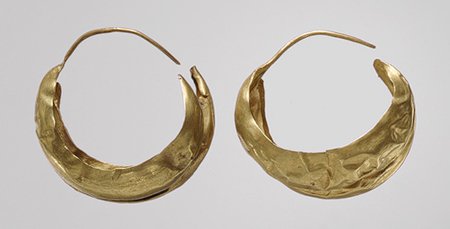 |
|
Lunate earrings, 2500–2400 B.C.; |
"Archaeological evidence reveals the common use of ornaments in the shape of the sun disk or inverted moon crescent, a symbol of the goddess Ishtar-Astarte, worn by women or animals to increase their fertility (Jdg. 8:21)." (New Bible Dictionary, Article "Amulets," p.34)
In that day יהוה takes away the finery of the anklets, and the headbands, and the crescents, the pendants, the bracelets and the veils, the headdresses, and the leg ornaments, and the sashes, and the perfume bottles, and the amulets, the rings, and the nose jewels, the costly robes, and the cloaks, and the shawls, and the purses, the mirrors, and the fine linen, and the turbans, and the large veils. (Isaiah 3:18-23, ISR)
The Hebrew word (H7720 - śaharōnîm), here translated as "crescent," is found only three times in Scripture and is used only in connection to heathen idolatry (Judges 8:21 & 26; Isaiah 3:18). This word is never associated with the "New Moon" or even the "month." Not one of the inspired authors of Scripture used śaharōnîm when writing about the appointed feasts or the month.
"The Crescent was a favorite amulet among many peoples of Western Asia, and it represented to them the strength and protection of the waxing and not the waning moon." (Amulets and Superstitions, E. A. Wallis Budge, p.213)
"Before Jacob went to Bethel to present himself before Yahweh he made all his people to hand over to him their 'strange gods' and ear-rings (i.e. crescent-shaped amulets), and he hid them under the oak which was in Shechem [Genesis 35:4]." (Ibid, p. 214)
It is worth noting that Sin, one of Babylon's chief gods, is represented by a crescent.
"On cylinder seals, he [Sin] is represented as an old man with a flowing beard and the crescent symbol. . . . The cult of the moon-god spread to other centers, so that temples to him are found in all the large cities of Babylonia and Assyria." (http://en.wikipedia.org/wiki/Sin_(mythology))
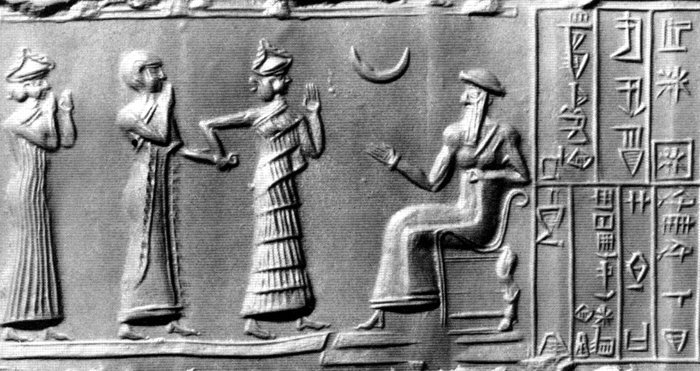
Sin worship was also prevalent in Arabia in the days of Muhammad. Consequently, Islam venerates the crescent to this day. Many religions with Babylonian roots venerate the crescent (i.e. Roman Catholicism, Hinduism, Buddhism, etc.).
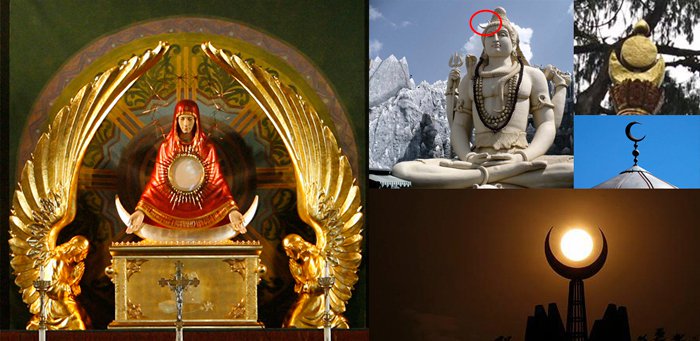
The idolatrous practices of the heathen religions, rooted in Babylon, stand in austere opposition to Yahuwah's admonitions for His people.
And take heed, lest you lift your eyes to heaven, and when you see the sun, the moon, and the stars, all the host of heaven, you feel driven to worship them and serve them, which Yahuwah your Eloah, has given to all the peoples under the whole heaven as a heritage. (See Deuteronomy 4:19.)
About 600 years before the birth of our Saviour, Yahuwah reprimanded the inhabitants of Judah through the prophet Jeremiah for their idolatrous behavior, which included making crescent shaped cakes as an offering to the "queen of heaven." Sadly, the men of Judah did not heed Jeremiah's warning, as they believed that their idolatrous practices were the source of their prosperity.
"But since we left off to burn incense to the queen of heaven, and to pour out drink offerings unto her, we have wanted all things, and have been consumed by the sword and by the famine. And when we burned incense to the queen of heaven, and poured out drink offerings unto her, did we make her cakes to worship her, and pour out drink offerings unto her, without our men?" (Jeremiah 44:18-19, KJV)
"To worship her - Rather, to represent her image. The cakes were made in the shape of a crescent to represent the moon." (Barnes Commentary)
"Crescent-shaped cakes were offered to the moon." (Jamieson-Fausset-Brown Commentary)
Throughout Scripture, crescent veneration is mentioned exclusively in relation to idolatry and Israel's adoption of heathen practices.
There is not a single shred of evidence to support the supposition that the Full Moon is the beacon for New Moon Day. Those who teach that the Full Moon is the New Moon do so primarily based on four assumptions/interpretations. We will take a brief look at each of these now.
According to those who advocate reckoning New Moon Day by the Full Moon...
(1) Claim: "A total solar eclipse occurred at noon (and lasted three hours - Matt.27:45) on the day of Yahushua's crucifixion (on the 14th day of the lunar month). A solar eclipse can only take place during conjunction. Therefore, the month must have begun with the full moon."
The Problem/Assumption: While it is true that a solar eclipse can only take place when the moon is in conjunction* (details below), a very clear problem with this assertion is found in the fact that there were no total solar eclipses in Jerusalem in the Spring of 31 AD.1 (http://eclipse.gsfc.nasa.gov/phase/phases0001.html)2 In fact, Jerusalem was not in the path of totality at any time during the first century. Another crushing blow to this supposition is that solar eclipses generally only last about 7-8 minutes, not 3 hours. "The longest total solar eclipse during the 8,000 year period from 3000 BC to 5000 AD will occur on July 16, 2186, when totality will last 7 min 29 s." (http://en.wikipedia.org/wiki/Solar_eclipse) The darkness that fell over the land at the Crucifixion was a miracle, and cannot be explained by any naturally occurring phenomenon. Claiming that there was a total solar eclipse, lasting three hours, at the time of Yahushua's crucifixion is outrageous and cannot be substantiated by even one piece of evidence.
*Solar eclipses always coincide with the lunar-solar conjunction. However, the monthly conjunction is not an eclipse. "Conjunction" simply denotes the location of these 2 heavenly bodies - beside each other - the moon is not in front of the sun [between the sun and the earth or vice versa].The sun and moon are in "conjunction" the moment they come together [being parallel] in their circuits within the dome above the flat earth, at the end/beginning of a lunation. It works exactly the same way each month – being Yahuwah's clockwork. The lunation (month) is not truly over until the moon enters conjunction with the sun, at which point it is totally dark [of its own accord] and after which it begins again to self-illuminate in a new circuit, rebuilding her own light to become a full moon, etc. Let it be clearly understood here, that the moon is self illuminating and does not reflect the light of the sun. The light of the sun, therefore, has nothing to do with the phases of the moon.
Related Content: How is "conjunction'' possible on a flat earth?"
1 The 70 Weeks Prophecy (Daniel 9) solidifies with certainty the year of Yahushua's Crucifixion.
(2) Claim: "A close study of the Greek word translated as 'darkened' in Luke's account of the Crucifixion reveals that the sun was eclipsed by the moon, which can only happen at conjunction."
"And the sun was darkened, and the veil of the temple was rent in the midst." (Luke 23:45, KJV)
Some, who advocate using the Full Moon, have purported that the word translated as "darkened" in this passage is the Greek word ekleipō [Strong's G1587], the root word of our modern "eclipse". They say that this proves that it was a solar eclipse that darkened the land at the Crucifixion. As discussed in the previous point (#1), this is an absolute impossibility. The darkness that engulfed the land at the Crucifixion was a supernatural manifestation, the testimony of Yahuwah. Nevertheless, let us examine the problems with this assertion.
The Problem/Assumption: The word translated in this passage as "darkened" is skotizō [Strong's G4654], not ekleipō [Strong's G1587].
"And [G2532] the [G3588] sun [G2246] was darkened [G4654], and [G2532] the [G3588] veil [G2665] of the [G3588] temple [G3485] was rent [G4977] in the midst. [G3319]" (Luke 23:45, KJV)
Skotizō simply means "to cover with darkness, to darken, to be covered with darkness, . . ." It can refer to metaphorical darkness (e.g. Eph. 4:18) or literal darkness (e.g. the heavenly bodies; Rev. 8:12). Ekleipō, while it is the root word for our modern "eclipse" and can refer to an eclipse of the sun, generally means "fail, to leave out, omit, pass by, . . ." Nothing about this word is specific to the sun or the heavenly bodies.
Ekleipō is found in only three passages of Scripture, none of which are specific to the moon's motion relative to the sun:
"And I say unto you, Make to yourselves friends of the mammon of unrighteousness; that, when ye fail [G1587 - ekleipō], they may receive you into everlasting habitations." (Luke 16:9, KJV)
"But I have prayed for thee, that thy faith fail [G1587 - ekleipō] not: and when thou art converted, strengthen thy brethren." (Luke 22:32, KJV)
"And as a vesture shalt thou fold them up, and they shall be changed: but thou art the same, and thy years shall [G1587 - ekleipō] not fail [G1587 - ekleipō]. " (Hebrews 1:12, KJV)
Even in light of the common usage/meaning of this word (ekleipō), which irrefutably negates the claim being examined, it bears repeating that this word is not even found in the proof text being offered to prop up the Full Moon reckoning of New Moon Day, despite what some are alleging.
(3) Claim: "The woman in Revelation 12, clothed with the sun, with the moon under her feet, and the stars above her head is the announcement of New Year's Day. On one day each spring, the constellation of Virgo is seen rising in the east with the full moon under her feet. She is also "clothed with the sun" in the sense that it is not completely dark outside when this phenomenon takes place. She has 12 stars on her head, meaning that she is the head of the year. Therefore, the full moon under Virgo's feet is the beacon for New Moon Day, and the beginning of the year."
"And there appeared a great wonder in heaven; a woman clothed with the sun, and the moon under her feet, and upon her head a crown of twelve stars." (Revelation 12:1, KJV)
The Problem/Assumption: Nowhere in the text is it even implied that this phenomenon is the beacon for New Moon Day, or the beginning of the year. Nor does this text say that the woman is standing on a "full moon." If we are going to honestly evaluate every detail of the description of the woman, then we must recognize that in addition to standing on the moon, she is clothed with the sun. Rather than loosely interpreting "clothed with the sun" to mean that it is not yet completely dark when this phenomenon occurs, perhaps we should look for a time when Virgo ("the virgin") is literally clothed with the sun (with the sun midway through the constellation) while the moon is under her feet. Is there such a phenomenon? Yes, it happens every fall, often (but not always) coinciding with the beginning of the Seventh Month.
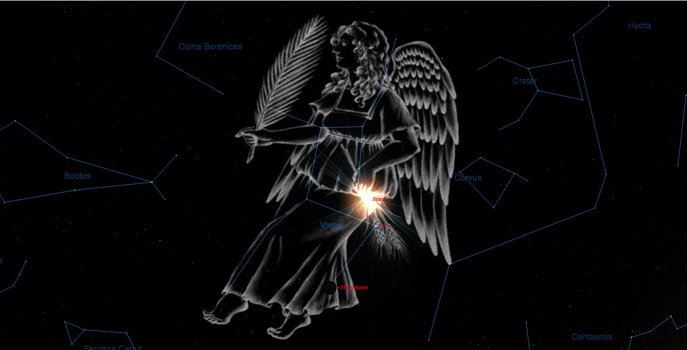
Virgo: This phenomenon happens on one lunation every Fall. Nothing in the text, however, indicates that this has anything to do with New Moon Day or the New Year. Those who defend the Full Moon reckoning based on the partial fulfillment of this description (Rev.12:1) in the Spring are building exclusively on unfounded assumptions and conjecture.
While Revelation 12:1 is a divine confirmation that the true ekklesia throughout history has relied on the Sun, Moon, and Stars for determining the Sabbath and Holy Days, nowhere in the text is it even implied that the description of the woman has anything to do with New Moon Day or the beginning of the year.1 Those who attempt to use Revelation 12 as a proof for Full Moon reckoning, while they might have good intentions, are adding to the text and basing their interpretation exclusively on speculation.
1 Another problem with the supposition that the Full Moon under Virgos feet is the signal to begin the year is the sun's differing position in relation to the stars at each progressive equinox. Because the equinoxes move westward along the ecliptic relative to the fixed stars, the timing of this phenomenon (the full moon under Virgo's feet) is slowly drifting. Today, this phenomenon generally occurs in late April or early May. Only 2,000 years ago, however, this same event took place several weeks earlier, in late March or early April. If we fast forward 2,000 years using the current rate of change, this phenomenon will not take place until late May or early June.
(4) Claim: "Psalm 81:3 says that the trumpet was to be sounded at the Full Moon because it is the New Moon."
"Blow up the trumpet in the new moon, in the time appointed [H3677], on our solemn feast day [H2282]." (Psalm 81:3, KJV)
H3677 (keh'-seh) - Apparently from H3680; properly fulness or the full moon, that is, its festival: - (time) appointed. (Strong's Greek & Hebrew Dictionary)1
H2282 (khag) -This word refers especially to a "feast observed by a pilgrimage." (The New Strong's Expanded Dictionary of Bible Words)
The Problem/Assumption: New Moon Day is nowhere called a khag in Scripture. Some who advocate this method would argue that this is not true by pointing to Hosea 2:11 and Ezekiel 45:17, but the "new moons" in these texts are mentioned apart from the Sabbaths and khag(s). Even if New Moon Days were referred to as khag(s), there is a second obstacle in this passage that cannot be resolved by those who teach that Psalms 81:3 proves that the trumpet was to be sounded at the Full Moon because it is the New Moon: In context, Psalm 81 is talking about Israel's exodus from Egypt. The most reasonable interpretation of verse 3 is that it is referring to the full moon that coincides with Passover and the Feast of Unleavened Bread. (Israel was led out of Egypt by night (Deut.16:1) on the first day of Unleavened Bread (Num.33:3) - on the 15th.)
A strong evidence against the Full Moon being the beacon for New Moon Day is noted when studying the timing of the feasts. Two important pilgrimage feasts take place on the 15th of the month. They are the Feast of Unleavened Bread and the Feast of Tabernacles. In His divine providence, Yahuwah has ordained that the timing of these two feasts coincide with the Full Moon, to ease the travel burdens of His people. Our loving Father is an Eloah of details, and nothing escapes His attention. When He requires a pilgrimage, He orchestrates the timing when it is most convenient for His people.2 This we see also in the fact that there are no pilgrimages required in the Winter. Thus, if He was careful to avoid mandating a pilgrimage in the Winter, He would also be lovingly careful to avoid ordaining a pilgrimage feast when the moon is almost totally dark.
1 Some have suggested that keh'seh, based on its root word (H3680; kâsâh), should be translated as "concealed moon" as opposed to "full moon," meaning that the trumpet should be sounded when the moon is dark (i.e. conjunction) to signal New Moon Day. Even this interpretation is in harmony with the dawn after conjunction method of reckoning.
2 Using the Full Moon reckoning, the second Sabbath of each month, including the high Sabbaths of the Feast of Unleavened Bread and the Feast of Tabernacles, will take place in total darkness.
The New Moon: Chodesh (H2320)
The Hebrew word that is translated in Scripture as "new moon" is chodesh [H2320]. The root of chodesh is chadash [H2318], which means "to be new, renew, repair."
A very clear issue is presented when reckoning New Moon Day by the Full Moon, in that the moon from day one is being torn down (losing light), not being renewed. Immediately after the moon becomes full, it begins surrendering light. This means that between the evening that the New Moon is declared and the morrow that is recognized as "New Moon Day," the moon will have already lost light, and will continue to lose light until the middle of the month, after which it will again begin to rebuild. The Full Moon reckoning defies all logic and is not true to the meaning of the word(s) - chodesh/chadash.
Distinguishing Days by the Moon's Appearance
Something else to note here is that because there will be one or two dark days in the middle of the month when using the Full Moon reckoning, the quarter phases of the moon will not regularly announce the Sabbaths. When reckoning New Moon Day by the Full Moon1, the subsequent phases of the moon become inconsistent and unpredictable, robbing the moon of its divine role as a beacon, and making the reliable identification of days by the moon's appearance very difficult, if not impossible.1 It is worth noting that the moon can appear full for more than one day each month. This would make consistent reckoning for observers very difficult.
While there are other secondary passages cited by those advocating the Full Moon reckoning, they deserve no response, as all (without exception) are nothing more than the expositor's efforts to force their presupposition into the text, a misleading effort to make Scripture agree with their ideas. There is not a single shred of evidence to support the Full Moon reckoning.
One thing is certain; the method being used to reckon New Moon Day in Yahushua's day was the correct one. There is no indication in the New Testament that there was ever a dispute as to when the Sabbaths and Feast Days occurred. Clearly, the method then being used was correct, as it was endorsed by Yahushua.
Many sincere lunar Sabbatarians often cite Jewish oral tradition (i.e. the Babylonian Talmud) as evidence that the first visible crescent was being used in Yahushua's day to reckon New Moon Day. But is the Talmud reliable? Can we, with Heaven's blessing, sweep all contrary evidence aside in favor of building primarily on the oral traditions of the those who trace their roots to the Pharisees?
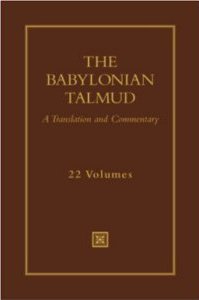 The Talmud essentially consists of two parts: (1) Mishna: First major publication of the Jewish oral traditions, 220 AD; (2) Gemara: Rabbinical analysis of and commentary on the Mishnah, c. 500 AD. In the Mishnah, we find many rules, regulations, and references pertaining to the rabbinical court's role in examining witnesses to ascertain if the new moon had been sighted. For example:
The Talmud essentially consists of two parts: (1) Mishna: First major publication of the Jewish oral traditions, 220 AD; (2) Gemara: Rabbinical analysis of and commentary on the Mishnah, c. 500 AD. In the Mishnah, we find many rules, regulations, and references pertaining to the rabbinical court's role in examining witnesses to ascertain if the new moon had been sighted. For example:
"The following are considered incompetent to be witnesses: gamblers with dice, usurers, pigeon breeders, those who deal with the produce of the sabbatic year, and slaves. This is the rule: All evidence that cannot be received from a woman cannot be received from any of the above. . . . Whenever (witnesses) must be on the road a day and a night, it will be lawful to violate the Sabbath to travel thereon, to give their evidence as to the appearance of the moon." (Babylonian Talmud, Section Moed, Rosh Hashana, Chapter I, http://www.jewishvirtuallibrary.org/jsource/Talmud/rh1.html)
Note: The above quotation actually makes no sense in the context of the Biblical luni-solar calendar. The earliest the moon could be sighted using the first visible crescent method would be following the sunset of the last Sabbath (the 29th). It makes no sense, then, to make allowances for someone to travel on the Sabbath to testify that they had sighted the moon before a moon sighting would even be possible. The Talmud, though, does not vindicate the Biblical calendar. Rather, it promotes Babylonian calendar principles (e.g. sunset to sunset days) and pagan calendation (e.g. Saturday Sabbath).
"There was a large court in Jerusalem called Beth Ya'azeq, where all the witnesses met, and where they were examined by the Beth Din. Great feasts were made there for (the witnesses) in order to induce them to come frequently. . . . How were the witnesses examined? The first pair were examined first. The elder was introduced first, and they said to him: Tell us in what form thou sawest the moon; was it before or behind the sun? Was it to the north or the south (of the sun)? What was its elevation on the horizon? Towards which side was its inclination? What was the width of its disk? If he answered before the sun, his evidence was worthless. After this they introduced the younger (witness) and he was examined; if their testimony was found to agree, it was accepted as valid; the remaining pairs (of witnesses) were asked leading questions, not because their testimony was necessary, but only to prevent them departing, disappointed . . . " (Babylonian Talmud, Section Moed, Rosh Hashana, Chapter II, http://www.jewishvirtuallibrary.org/jsource/Talmud/rh2.html )
"R. Gamaliel had on a tablet, and on a wall of his upper room, illustrations of the various phases of the moon, which he used to show to the common people, saying: 'Did you see the moon like this figure or like this?'" (Ibid.)
The Talmud, though, vindicates many unBiblical doctrines. For example:
Four beginnings to the year - "There are four New Year days, viz.: The first of Nissan is New Year for (the ascension of) Kings and for (the regular rotation of) festivals; the first of Elul is New Year for the cattle-tithe, but according to R. Eliezer and R. Simeon, it is on the first of Tishri. The first of Tishri is New Year's day, for ordinary years, and for sabbatic years and jubilees; and also for the planting of trees and for herbs. On the first day of Shebhat is the New Year for trees, according to the school of Shammai; but the school of Hillel says it is on the fifteenth of the same month." [Note: The Babylonian names of the months.] (http://www.jewishvirtuallibrary.org/jsource/Talmud/rh1.html)
Saturday Sabbath (with a sunset to sunset reckoning) - "The rabbis taught: One shall not send a letter by a Gentile on Friday unless he stipulated a certain sum for the delivery. If such a stipulation was not made, the Beth Shamai says it must not be delivered, unless the messenger has time to reach the house in which it is to be delivered (before sunset); the Beth Hillel, however, maintains: He may do it if the messenger has time to reach the house nearest to the wall of the city where the letter is to be delivered." (Babylonian Talmud, Section Moed, Shabbat, Chapter II, http://www.jewishvirtuallibrary.org/jsource/Talmud/shabbat1.html)
Was a Saturday Sabbath (Friday evening to Saturday evening) being observed by Yahuwah's faithful during Yahushua's earthly ministry? No, absolutely not. Scripture is clear that Yahuwah's calendar is luni-solar, and a Biblical day begins at dawn, not sunset The unBiblical Saturday Sabbath was clearly adopted by the authors of the Talmud after the first century1, as was the Babylonian practice of beginning the day at sunset. This point cannot be overemphasized. We know with certainty that these unBiblical practices were adopted after the time of Yahushua, yet there they are, side by side with the same authors' testimony that the New Moon was reckoned by the first visible crescent. It does not seem reasonable or responsible to suggest that we should embrace the first visible crescent methodology (and alleged history) espoused by the authors of the Talmud, when we have full knowledge that the same group of individuals penned doctrines that are antithetical to the plain teachings of Scripture. Clearly, the Talmud is not a trustworthy reflection of the Jewish economy during the earthly ministry of Yahushua.
|
The Babylonian Talmud, according to the rabbis who penned it, is more deserving of obedience than the Bible! "It is written [Ecclesiastes xii. 12]: . . . This means: 'My son, be careful in the observance of the rabbinical commandments (even more than in the biblical); for while the biblical commandments are for the most part positive and negative . . . the rabbinical commandments, if infracted, would involve capital punishment." (The Babylonian Talmud, Section Moed, Erubin 21b, Chapter II, http://www.jewishvirtuallibrary.org/jsource/Talmud/eruvin2.html) |
Also included in the Talmud is an incredibly vast list of almost every act imaginable that is either allowed or forbidden on the Sabbath - according to the rabbis. The Talmud is essentially a compilation of the exactions and traditions set forth by the Pharisees. How much weight can we give a book whose foundation is established on nothing more than the oral traditions of those who rejected the Lamb of Yahuwah and shunned the Light of the world?
"Then came to Yahushua scribes and Pharisees, which were of Jerusalem, saying, Why do thy disciples transgress the tradition of the elders? for they wash not their hands when they eat bread. But he answered and said unto them, Why do ye also transgress the commandment of Elohim by your tradition?" (Matthew 15:1-3, RNKJV)
We must never give more weight to tradition than is due. While all available information must be taken into consideration when conducting an honest investigation, we must always consider the source and pledge our allegiance to the weight of evidence, even if the conclusion does not agree with our presupposition.
While many historians, encyclopedias, and Bible dictionaries testify that the Biblical month began with the first visible crescent, none offer any real evidence to support their claims. It seems likely that they are relying largely on tradition, as the authors of the Universal Jewish Encyclopedia readily admit.
"Little is known of the procedure of determining the calendar up to the 2nd cent. C.E., when a description is given of the traditional practice, it ran as follows: On the thirtieth day of the month a council would meet to receive the testimony of witnesses that they had seen the new moon. If two trustworthy witnesses had made deposition to that effect on that day, the council proclaimed a new month to begin on that day… If no witnesses appeared, however, the new moon was considered as beginning on the day following the thirtieth." (Universal Jewish Encyclopedia, p.632)
The point, here, is simply this. We cannot, as responsible Bible students, build exclusively upon the oral traditions of the Jews, while sweeping all other evidence under the proverbial rug. We must prayerfully commit ourselves always to the weight of evidence, wherever it may lead.
1 Some have suggested that the Babylonian practice of observing a Saturday Sabbath and beginning the day at sunset was learned by the Jews during their Babylonian captivity. This is certainly a possibility. However, we can be sure that Yahushua did not endorse these or any other unBiblical practices. The point here is simply that the doctrines endorsed by the Talmud are not a trustworthy reflection of the mainstream Jewish economy during the earthly ministry of Yahushua. That being established, we cannot responsibly use the Talmud to justify using the first visible crescent.
Finally brethren,
"Prove all things; hold fast that which is good."
(1 Thess. 5:21, KJV)
_______________________________________________________
Related Content: